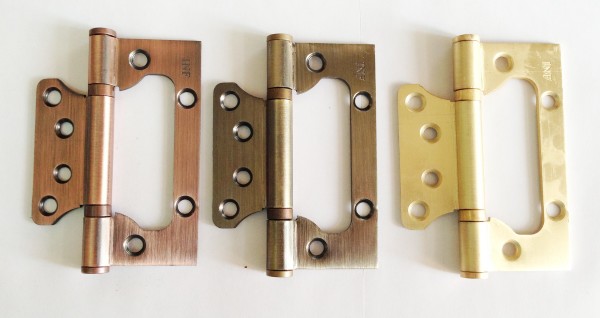
Instead of traditional loops, so-called "butterflies" or, in other words, overhead models are used. These products have a number of distinctive features that directly affect the way they are installed.
Overhead door hinges are simply fastened with self-tapping screws on top of the leaf without tie-in
First you need to understand the essence of the design of butterfly loops. They belong to the category of card models, in appearance these details resemble a butterfly, for which they received such a name.
Standard mortise hinges are installed flush, that is, it is necessary to make a recess in the door and frame, removing a few millimeters of material. Overhead views in this regard have cardinal differences, they can be mounted directly on the lining of the canvas itself, without preliminary surface preparation.
Such installation of overhead models of loops without tie-in is possible due to a number of nuances. The fact is that when closing the door, both halves of the fasteners must ensure a snug fit of the end of the leaf to the loot. In this case, this is possible due to the design features of the plates. In conventional products, they are straight and therefore they need to be deepened into the material. Here, the two halves are elements of a whole plate, they are cut in such a way that when closing, one part enters the other without forming gaps.
The main advantage of overhead hinges is their ease of installation, it is enough just to determine their position and fix them with self-tapping screws. However, there are a number of downsides to consider as well.
Disadvantages of butterfly loops:

The special design of these models allows installation without tie-in, but this installation method has its drawbacks.
It is in connection with these points that mortise models are mainly used. If you are installing doors for the first time, overhead options will be your best choice.
Let's look at how these mounts are installed. To mount the "butterflies" you will need a minimum set of tools:
First you need to determine the places for screwing the hinges, for this, measure with a tape measure about 20-25 centimeters from the top and bottom edges of the door, this will be the starting point for each hinge. It is better to fasten the lower one further from the edge in order to reduce the load on the upper part of the fittings.
Since the installation of the hinges is done without a tie-in, immediately attach the plate to the end of the canvas and mark the location of the holes with an awl. Then carefully drill them so that the screws can be easily screwed into the door.

Butterfly loop installation sequence
After the initial installation, you need to determine the location of the plates on the door frame. To do this, you need to attach the canvas and roughly outline their positions. Then unscrew the hinges and more accurately mark the places for drilling.
After all the holes are ready, simply attach the canvas to the opening and screw both plates with self-tapping screws. Check the door movement, as in some cases defects may occur, which, however, are easy to eliminate.
Since it is possible to ideally install butterfly loops without a tie-in only if there is a flat canvas and a straight loot, some shortcomings may occur during the work. One of the most common problems is the formation of a gap between the plate and the box. In this case, the door will not close tightly, and over time, the entire structure will loosen and will overwrite the threshold.
To solve this problem, you will need a gasket, it can be made from wood chips, cardboard, gum, or use a regular match. Of course, this will somewhat affect the quality of the connection, but you can bring the loops to the desired position.

If the installation rules are followed, the door will fit snugly
Some overhead loops have an additional detail in their design, which allows you to move the sides of the product to ensure a tight fit of the halves of the plate.
If this method does not suit you, you will have to slightly modify the design by turning the overhead "butterflies" into semi-overhead ones. In other words, one part of them will have to be drowned a little. Usually they cut a large plate on the box. Making such a small cut is quite difficult, especially considering the shape of the product.
If the installation has been done correctly, the doors will move silently and pretend to be tight. Otherwise, it is better to replace the "butterflies" with standard mortise products.